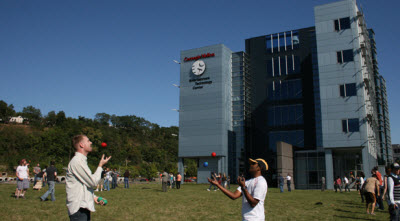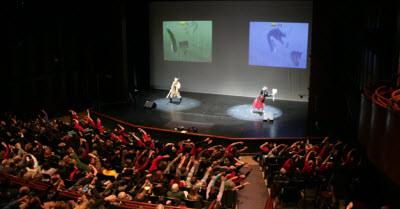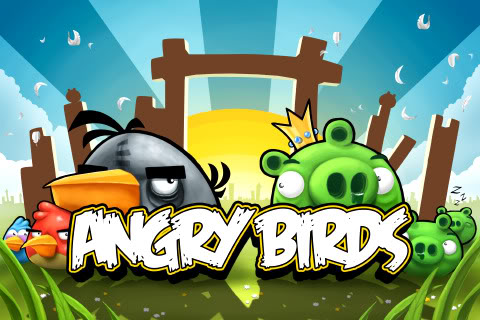Disclosure: The organizers of Siggraph paid part of my expenses to Anaheim, Calif. Our coverage remains objective.
One of early giants in computer-generated animation is helping a new generation of would-be digital entertainers learn about starting their own businesses.
Carl Rosendahl is a pioneer in CG filmmaking as the founder and president of Pacific Data Images, the animation company that created the film Antz in 1998. He sold 40 percent of the film to DreamWorks in 1995 and then sold the rest of it in 2000. The company is still making lots of animated films, giving Disney’s Pixar studio some serious competition in the renaissance of computer-generated movies. Rosendahl moved on to become a venture capitalist at Mobius Venture Capital, but he didn’t like that so much during the depth of the dotcom crash.
Now he is an associate professor at the Entertainment Technology Center at Carnegie Mellon University, where he teaches, among other things, game entrepreneurship. In the program, he takes students through the process of creating a new game company and getting them to work on their first product. As he knows from experience, it isn’t an easy task.
We interview Rosendahl at the Siggraph Business Symposium in Anaheim, Calif., this week. Here’s an edited transcript of our interview.
GamesBeat: Tell me about the university program.
Carl Rosendahl: It’s the Entertainment Technology Center at Carnegie Mellon. It’s a two-year master’s program between the drama department and the computer science department. They originally came together 15 or 20 years ago to create the program. It’s very much a project-based curriculum. The first semester, there’s a lot of core classes that everyone takes. After that, each semester the students work in teams of four to eight on a single project.
As faculty members, we teach some elective classes, but a lot of what we do is mentor and advise them through the process of creating these projects. Some of them are done in conjunction with outside companies. We do things with Microsoft, Electronic Arts, Lockheed, all sorts of corporations. Some of the projects are student-pitched and some are faculty-pitched.
GamesBeat: How much of the focus is on running a game project or running a game studio versus running other kinds of businesses?
Rosendahl: Most of the projects are interactive-based. There are a few linear projects. But they’re all over the map. A lot of them are game-oriented, but some of them are location-based installations. That can be entertainment, but it can also be activities for — there’s a great project with the Children’s Museum in Pittsburgh that’s essentially doing maker technology. Kids can go in and learn how to design and build things.
GamesBeat: Do you run into a lot of common mistakes that people make when they’re starting off in things like this, either starting a game or starting a studio?
Rosendahl: Sure. I do an elective class on entrepreneurship. I try to expose them to the whole first-year life cycle of what you go through in the context of doing entertainment technology of some sort. I have the students create a fictitious company in teams of two and walk them through the whole process. Most of the projects, though, the core curriculum the students work on, are real projects where the build, at a minimum, a functioning prototype by the end of the semester.
They run into all sorts of challenges. At the beginning, sometimes the definitions of these projects are pretty broad. It’s a few paragraphs explaining what they’re going to do. Sometimes it’s much more well defined. They spend the first three weeks or so doing conceptual design, and then after that they spend the rest of the semester building the prototype and doing a very iterative process. Get something to work. Do a lot of user testing. Get feedback from that. Iterate through that. A lot of times they refine the project based on real user feedback.
GamesBeat: It sounds like hands-on is the best way to teach people this.
Rosendahl: Absolutely. They run into all sorts of challenges. They run into scoping issues all the time. Every semester, on every project, their vision of what they’re going to accomplish in 16 weeks is almost always much greater than what they can accomplish in 16 weeks. Sometimes it’s technology. Sometimes it’s with a client. Sometimes it’s your users. It turns out that your idea wasn’t so great after all, or people aren’t adapting to it the way you wanted them to.
Then you have great opportunities for learning about being on a team. [Laughs] All the issues with how you cooperate together, how you maximize everyone’s contribution, and sometimes how you deal with all the conflicts that come up. I say “sometimes.” It should be “usually.” Conflicts arise in the teams. We help work with them and teach them how to figure out the best path through those situations.
GamesBeat: There’s this vocational aspect to it. If you look at it from three miles up, what do you see in the games industry itself? What do you think is changing? There seem to be some good things happening, like Kickstarter. That’s helping a lot of games get off the ground now. There are also a lot of things in the way of trying to start something smaller.
Rosendahl: On the one hand, it’s an amazing time to be a game developer or any other kind of interactive project developer. So many off-the-shelf tools are available. They’re incredibly powerful and cheap, if not free. You can get up and running very fast and develop a prototype for people to start playing with almost instantly. That’s very exciting.
The challenge is that everyone else has access to all that, too. [Laughs] The barriers to entry are essentially zero now, so you need incredible creative abilities to imagine something unique that no one else is doing. You need the ability to deliver visually stunning work, because the audience expectation is so high. If you’re in a position where you can push yourself forward by doing unique R&D and not just relying on off-the-shelf tools – if you can develop tools, techniques, pipelines, whatever that give you the ability to produce stuff that isn’t available that way, or do it more efficiently or effectively somehow – these guys will have some very interesting things to say about how they get a competitive edge out of doing that.
It’s an interesting balance. On the one hand, there’s incredible opportunity, because if you have an idea you can start implementing it right away. Then there’s the challenge of how you differentiate yourself against everyone else.
GamesBeat: With Pacific Data Images, is there a comparison you would make there to how you guys got off the ground?
Rosendahl: I started PDI in 1980. There was no off-the-shelf software. A computer animation system was called a “C compiler.” [laughs] It’d do anything if you could tell it what to do. It was a very large challenge to develop a computer animation system from scratch and make it do what you wanted it to do. In fact, it took us a few years to be able to do broadcast graphics and then leverage off of that. We had a long-term vision of getting to the point where we could make a fully animated feature film. It took us about 15 years to get there. It wasn’t possible when we started, but technology and the skill sets of the people we brought in all converged on that vision. Today it’s a different world.
GamesBeat: There is no R&D anymore, right?
Rosendahl: There is, but it’s very different. It’s on the edges, trying to figure out what R&D you can do to gain an edge over everyone else. As opposed to a green field, where you can go in and just create stuff because very few other people are doing the same. In fact, if you look back at the ’80s, everyone who was trying to do that—technically, we were competitors, but more realistically we were co-conspirators. We all wanted the industry to succeed.
Even when you lost a job to one of your competitors, you wanted them to do really well, because that would create demand. The clients would say, “We had a great experience. We got a wonderful product. We want to keep doing that.” If they blew it, people would say, “Eh, computer animation, that’s hard to do, it’s expensive, it sucks.” The competitive landscape is very different now.
GamesBeat: Is there a direction that you’d encourage people to go in or look at if they don’t have an idea of exactly what they want to do yet?
Rosendahl: All the augmented reality stuff is a huge opportunity. We’re only beginning to imagine what can be done with that, and only beginning to get the hardware that’s going to implement it. Google Glass is very cool — but it’s the first generation. Jump out 15 years and that’s going to be pretty amazing stuff, when you get to the fourth or fifth generation. We’ll just laugh at all the versions today. “They were big, they were clunky, low resolution, slow, cumbersome.” All those issues are going to go away.
To me, the big open opportunity is, “What do you build for that?” Don’t look at what you build for Oculus Rift or Google Glass today. Look at what you’re going to want to build when that technology is four generations older. Then figure out what tools you want to start putting into place today, what skill sets you want to start developing today, that are going to be valuable down the road when that technology is starting to mature.
GamesBeat: What do you find about the success rate or failure rate among the indies? We always hear about folks like the Temple Run guys who create something really successful, but it’s hard to get a grip on how much activity there is out there. Sometimes I think there are way too many game startups. Half the attendees at GDC now identify as indies.
Rosendahl: That’s the good side and the bad side. Anyone can do it, so everyone is doing it, so you have a very crowded field. Some wonderful, unique stuff will come out of that. Eventually it will have to stabilize. It’s the Wild West right now. It’s a rebirth of the game industry.
You had a game industry that was mature before digital distribution. Everyone understood how it worked. A few large companies were responsible for publishing and distribution and much of the game creation. That all changed, almost overnight. Now it’s changing again with all the indie studios. That will eventually settle at some point. I have no idea what it will be like then.
I do think that there will be a lot of change in the way that we play games. There will be the sit-at-home-with-a-big-screen experience. There will be the mobile experience, although mobile devices 10 years from now, who knows what they’re going to be? I think it’s all going to be wearable. That’s going to create new opportunities. My personal feeling is that all the stuff people are developing now is practicing and trying to figure out the creative abilities we’ll need in the next big shift.
GamesBeat: I don’t necessarily see a lot of examples of companies successfully adapting to this new world. Electronic Arts says a very large percentage of its revenue is digital now, but they’re treading water on profits and revenues are shrinking. It’s hard to find companies that are figuring it out.
Rosendahl: It’s a challenging environment, with all these changes. For all the — it sounds funny to say “traditional game companies,” because it’s all such a new industry — but this is a fundamental shift in their business. The fact that they’ve survived at all is pretty good.
GamesBeat: You’ve been in film and gaming both. Which seems to have a more interesting future as far as startups are concerned?
Rosendahl: Gaming, for sure. I’m a pessimist about the future of the film industry. I think there will always be linear entertainment. We will always want to just sit back and have a story told to us. But the percentage of our entertainment time that takes up will be less and less. People love things that are new and different. Films are not that anymore. They can only get bigger and louder and more complex to be interesting to an audience. There’s a limit to how big and loud you can go.
There is very little innovation happening in linear media, from a technology standpoint. Even from a creative standpoint. It’s hard to tell a story or make a visual experience that hasn’t already been done. For interactive, it’s brand new. Even if you look at the 30 years, 35 years of the digital game industry, it’s still a baby. It’s still figuring everything out.
GamesBeat: Do you have to keep on servicing the fans of that experience first? Pocket God went on forever in the mobile space. Temple Run’s spinoffs haven’t finished coming out yet. I don’t know if you’ve addressed that in your schooling, but it seems to me to be the reason why it’s so hard to run a business. There are so many one-hit wonders.
Rosendahl: The innovation part of it is really hard. Even those guys, with the one that was a hit, they didn’t know it was going to be a hit. I forget the exact numbers, but the number of tries that Rovio had before they hit Angry Birds was enormous.
Rosendahl: Right. So kudos to those guys for their tenacity and being willing to try it out. I’m sure that for a lot of these guys, once you have that huge hit it’s harder to do that. “Let’s try 50 different things and find out which one hits. Now we have a brand. We don’t want our brand to suddenly be the one that made one hit game and then 50 others that failed, but that’s how we made the first one!” That would be really bad for your brand now. That’s a difficult challenge, unless somehow you’re communicating that to your audience out there.
GamesBeat: What are some of the interesting people that get brought into these training programs? Is there some kind of best-practices collection of people that can teach how to run a game company?
Rosendahl: We don’t teach them how to run a game company, though. We teach them how to work in creative teams well, whether it’s for games or anything else. My entrepreneurship class is about the startup life. We usually bring in one or two entrepreneurs who are in the depths of it right now. The format I like to use with them is, “Tell us about three things you did right and three things you did wrong.” Part of it, with the students, is going out and interviewing an entrepreneur or finding first-person accounts and looking for those same things.
It’s hard to find an entrepreneur who will publicly tell you three things they did wrong. Partially because maybe they haven’t done the introspection yet. Also, you never want to admit that. But that’s where the lessons are. When you do something right, you don’t know whether you were smart or lucky. When you do something wrong, you pretty much know you screwed up. Well, that’s not quite right. There are a lot of things you do wrong that you decide were wrong in retrospect. But at the time, you made the best choice based on the information you had. That’s fine. That’s worth doing, as long as you learn from it. If it’s going down the wrong path, you change directions.
What I like to do, when we bring in speakers, is to bring in people from my entrepreneurship class who are still early in that process. They tend to look a little frazzled. They’re willing to share all the difficulties. Fundraising is always an issue. Finding the right customer fit and getting your product tuned so it works for a broad audience. Generally, whoever you made it for at the beginning isn’t necessarily the broad audience that you need to be successful. How do you change your product without losing your core audience or completely alienating your core audience? That’s assuming you found something with an audience in the first place, which is an anomaly for a lot of startups.
GamesBeat: Kickstarter feedback is interesting in that you’re getting real feedback before you do it. But you can also easily become a slave to responding to impossible demands.
Rosendahl: Right. There’s a hidden expense in doing that – customer support, communications, it’s a whole big PR thing. But it’s fantastic that that option exists for people. There are great things that have come out of it. And again, how old is that phenomenon? A couple of years? It’s far from settled. I’m sure we’ll see more successes. We’ll see some huge failures that get people very upset. I don’t think there’s been a giant crash and burn yet, but there will be. How that settles and whether it settles—The size of Kickstarter campaigns is getting larger and larger. Where does that end? Is there a natural limit to how big those projects can be? If they start getting really big, does that mean the small ones can’t exist anymore. I don’t know. It’ll be amazing to see.
VentureBeat's mission is to be a digital town square for technical decision-makers to gain knowledge about transformative enterprise technology and transact. Learn More






